Section 17 Industry. Geography of the main industries in the world (energy, metallurgy, mechanical engineering, chemical industry, forestry and woodworking industry, light industry).
Remember
Industry determines the economic potential of the country, the technical level of production, the degree of use of natural, material and labor resources.
For the curious
Over the past 100 years, industrial production has grown 50 times.
Industry of the world.
All industries, depending on the time of origin, are divided into three groups: old industries (coal, iron ore, metallurgical, textile, shipbuilding), the development of which is slowed down today, and the geography of location is changing in favor of developing countries, new industries (automotive, aluminum production, plastics, chemical fiber), which are concentrated mainly in developed countries, as well as in developing countries, where they are growing rapidly; the latest industries (electronics, computing, microbiological and aerospace industries), which are developing at a fast and stable pace, are located in economically developed and newly industrialized countries. "
Consider the geography of the main industries.
Fuel and energy industry.
The fuel and energy industry covers the areas of extraction, processing of fuels (fuel industry), production of electricity, its transportation and distribution (electricity). It supplies fuel and electricity to all industries; provides the population with heat and energy. The fuel and energy intersectoral complex is one of the most capital and capital intensive, requiring bulky and expensive equipment.
The current global scale of energy use exceeds 11 billion tons of fuel equivalent (tp) annually. The extraction of mineral fuels and the production of electricity are increasing. So, in the twentieth century. more fuel has been produced than in the entire previous history of mankind.
Oil (35.8%) prevails in the world fuel and energy balance today, followed by coal (25.8%) and natural gas (27.5%).
Among the regions of the world, the largest energy consumers are Asia, North America and Europe. Among individual countries of the world, previously developed countries and large countries, developing countries (USA, China, Russia, Japan, Germany, India, Canada, France, Great Britain, Italy) are singled out as the largest consumers of fuel and energy, and per capita - developed cranes (Canada, USA, Australia, Netherlands, France, Great Britain, Russia, Germany, Japan, Switzerland).
In the twentieth century. There have been significant shifts in the structure of the world use of primary energy resources: they stopped using firewood, the share of coal and oil shale decreased, but modern types of fuel - oil, natural gas - began to be widely used. This led to an increase in the prices of oil and natural gas, the price of which became 3-5 times higher than the cost of coal.
Fuel industry specializes in the extraction and processing of various types of fuel, primarily oil; coal, natural gas.
Coal industry- The oldest among the fuel and energy industries. During the XIX and in the first half of the XX century. coal industry was leading. The largest number of coal mining enterprises (mainly mines) was in the USA, Great Britain, Germany, and the USSR.
In the 50-60s of the twentieth century, the coal industry gave way to the oil, and later gas industry... Only the world energy crisis of 1973 contributed to the revival of coal mining, in particular, open pit mining, is relatively cheap.
In the 70-80s. XX century the world coal trade intensified. Countries that have significantly exhausted their coal resources (or their production has risen in price), began to give preference to the imported resource. In particular, the volumes of coal production were reduced by Germany, Great Britain, France, Belgium, Japan, and began to increase with the aim of further export to the USA, Australia, Poland, Indonesia, Colombia. The coal industry in China and India is actively developing. A growing economy at a rapid pace, requires a lot of fuel. Traditionally significant coal production has South Africa... For the policy of discrimination against the local black population, which was carried out by the South African authorities, the world community imposed an embargo (ban) on the import of oil into the country. After the embargo was lifted, excess coal was exported. The coal industry of countries with economies in transition - Russia, Ukraine, Kazakhstan - After radical market reforms, it is experiencing a deep crisis leading to significant reductions in coal production.
Coal quality is divided into: stone(Among its anthracite - the most high-calorie) - is used as fuel; coking- Used in metallurgy; brown- Has a high ash content and low calorie content.
Coal is mined by open (open-pit) and closed (mine) methods. The open method is much cheaper. The mines produce high-quality coking coal, which is used for the production of coke. Coal is also used in the chemical industry for the production of aniline dyes and medicines.
More coal is mined in China, USA, India, Germany, Russia, Australia, South Africa. Coal is mainly used in the countries where it is mined. Only 10% of the industry's products are exported. The main exporters of coal are the USA, South Africa and Australia. Japan imports coal, Western Europe, Brazil.
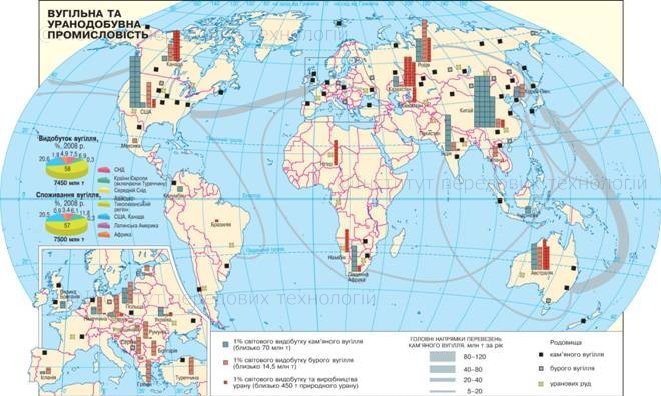
Coal and uranium mining industry
Coal mining is harmful to the environment. Significant territories are alienated for mines and waste rock heaps (waste heaps). During the transportation and processing of coal, soil, air and water are polluted. In areas where coal is mined, it is difficult to restore vegetation, especially woody, through impurities that increase the acidity of the soil. The slopes of hills with loose soil are easily washed away by heavy rains. Such territories require complex reclamation measures.
Oil industry developed in more than 80 countries around the world. Oil accounts for about 35% of all fuel used in the world. For today, the total world production oil exceeds 3.5 billion tons per year. There are three ways of oil production: gushing (possible only for "young" regions); pumping (much more expensive, used more often); mine (rarely used, for special types of "heavy" oil).
Oil is one of the most important commodities in the world market. It is widely used not only as a fuel, but also as a valuable chemical raw material (for the manufacture of plastics, resins, rubber, dyes). Oil from various fields is distinguished by its quality: the content of impurities, in particular - sulfur, paraffins, light fractions.
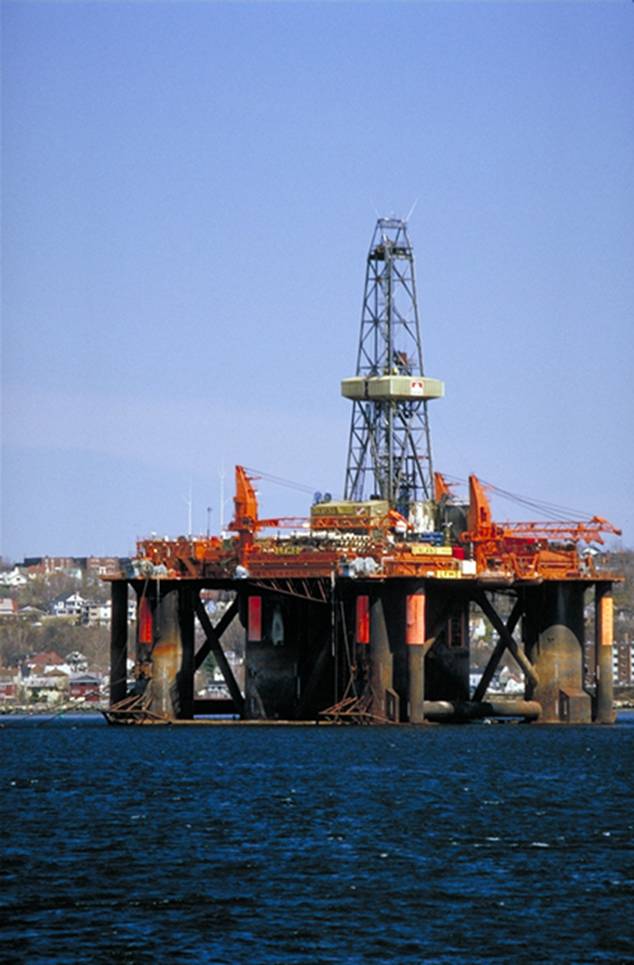
Extraction of oil from the seabed. Nova Scotia, Canada
Most of the oil is produced in Asian countries - 38%, followed by America - 21%. OPEC member countries account for about 40% of world production. The region of the Persian Gulf is especially prominent, within which 2/3 of the world's proven oil reserves and 1/3 of its production are located. The second important area is West Siberian Plain... In terms of oil reserves, the first place is Saudi Arabia, the second is Russia. However, the difficult natural conditions in Russia increase the cost of Russian oil. 40-50% of the oil produced is exported. The most important exporters of oil are the countries of the Middle East, Venezuela, Algeria, Libya, Russia. Europe, Japan and the USA are buying oil. Most of the oil is transported by oil tankers.
Refineries (refineries) are built near oil production sites, at consumers and oil pipelines. Preference is given to locating refineries with consumers, since transportation of crude oil is cheaper than transportation of petroleum products. Accordingly, most of the refineries are located in developed countries. More than 50 million tons of oil are processed annually by refineries in New York, Houston, Los Angeles, Rotterdam.
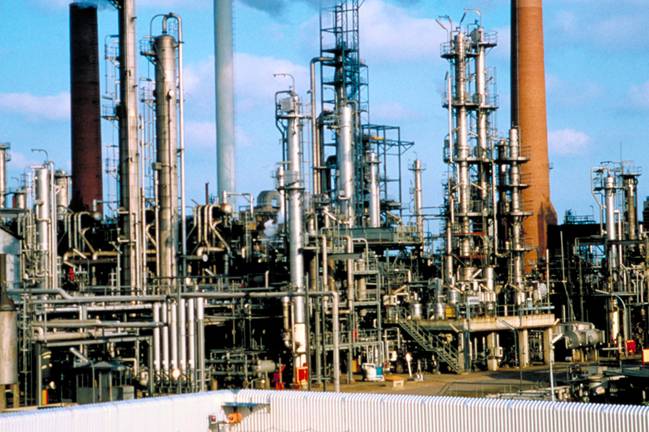
Oil refining enterprise. Germany
The world oil production is significantly hampered by the creation of the Oil Cartel, OPEC, which was established in 1960, which sets quotas (quantitative restrictions) to member countries for oil production. This organization is trying to regulate the amount of oil entering the world market by influencing world oil prices.
To maintain the achieved volumes and increase oil production, there is a need for exploration of new fields. Back in the middle of the twentieth century. the development of the sea shelf began actively. Today, about 1/4 of the world's oil is produced on the shelf. Significant areas of offshore production are the Persian Gulf (2/5 of the world's offshore production), the Maracaibo Gulf in Venezuela (1/4 of the world's offshore production), the Gulf of Mexico, the North Sea (Norway, Great Britain, Denmark), the Caspian Sea, the Gulf of Guinea (Nigeria) , South China Sea (Thailand, Malaysia, Brunei, Vietnam). The shelf zone of the Arctic Ocean and the Antarctic regions of the World Ocean are promising for oil.
Oil companies tend to be the largest industrial companies in the world. Most of them belong to American, British, French and Dutch capital. At the turn of the XX-XXI centuries. there was a merger of many companies. Among the largest oil companies, ExxonMobil, Shefron Texaco, Conoco Philips (USA), British Petroleum-Amoco (USA and Great Britain), Royal Dutch / Shell (Great Britain and the Netherlands), Total Fina Elf "(France and Belgium)," Eon "," RVE-DEA "(Germany), ENI (Italy). Significant reserves of oil and capital are concentrated by large companies in developing countries - Petrobras (Brazil), Pemex (Mexico), Petroven (Venezuela). Russia 5 large companies - Lukoil, TNK, Surgutneftegaz, Sibneft, Yuganskneftegaz. Oil companies in the Gulf and Africa are usually owned by members of the monarch's family or controlled by local elites.
Gas industry is developing at a very fast pace. This is due to the high heat capacity of the gas, ease of use, minimal pollution environment.
Gas is also important chemical raw materials... The share of natural gas in the structure of the fuel produced began to increase in the 60s of the twentieth century. If earlier the USA was the undoubted leader in gas production, then in the 1980s Russia practically caught up with them, and then surpassed them. At the same time, Canada, the Netherlands, Norway, Great Britain, Algeria, countries South-East Asia, The Persian Gulf, Latin America and Australia.
Today, Russia is the first in the world in terms of gas production, followed by the United States. Together, these countries produce half of the world's gas. Russia is one of the largest gas exporters. With main gas pipelines, it provides this fuel and energy resource to almost all of Europe. Algeria exports gas to the USA and Europe; the Gulf countries, Indonesia and Australia sell gas to Japan.
Production and processing of natural gas is usually concentrated within large oil companies (Gazprom (Russia), British HPP (Great Britain and the USA)).
Oil and gas production can lead to a variety of environmental problems. Mining voids can cause sinkholes. They are usually filled with water. Soot, formed as a result of accompanying gases, settling on the surface of the earth, in high latitudes causes melting of snow, the destruction of lichen - an important forage base for reindeer husbandry. Accidents on oil pipelines lead to soil pollution, groundwater... Oil production on the shelf can lead to the death of fish, birds and animals.
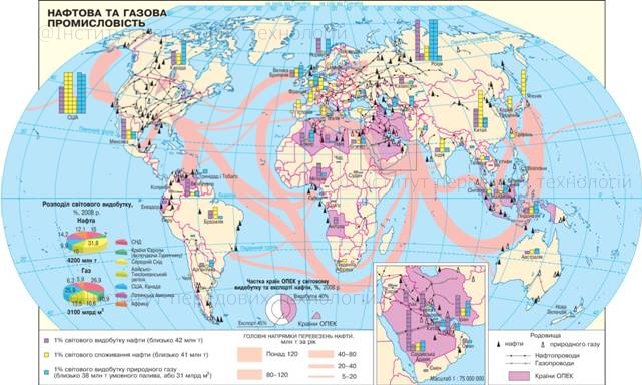
Oil and gas industry
The main task electric power industry is the production of electricity and its supply to all industries. Based on the level of development of the electric power industry, conclusions are drawn about the development of the country's fuel and energy complex as a whole. Large countries of the world - the USA, China, Japan, Russia, Canada - have become world leaders in terms of absolute volumes of electricity production.
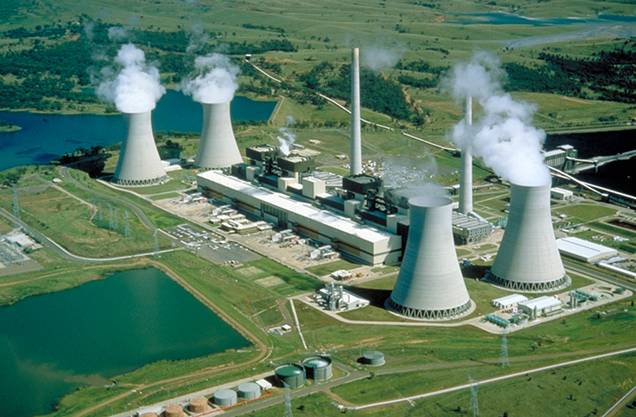
Power plant in South Wales
The most intensive increase in electricity production is in China, India, Brazil. It is developing at a relatively high rate in the USA, Japan, Canada, South Korea, South Africa, decreases - in Russia (demand decreases), Germany (thanks to the use of energy-saving technologies). More electricity per capita is produced in Norway (about 30 thousand kWh / person per year), Iceland, Canada, Sweden, USA, New Zealand, Australia, Finland. The poorest countries in the world produce only a few tens of kWh / person per year. This means that most of the population of these countries does not use electricity at all.

Power engineering
World trade in electricity is still underdeveloped. The largest exporters of electricity are France, Canada, Paraguay, importers - the United States, Germany, Italy, Brazil, Switzerland.
Depending on the resource potential different countries place bets on a certain method of generating electricity. In general, in the world, thermal power plants (TPPs) account for 67% of electricity production, hydroelectric power plants (HPPs) and nuclear power plants(NPP) - 16% each, other types of power plants - 1%.
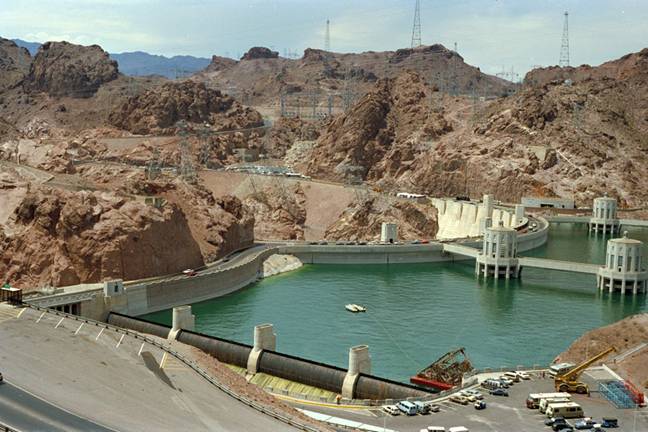
Dam on mountain river... Arizona, USA
The largest power plants have a capacity of over 3,000 MW. There are few such power plants in the world. The largest of them is Surgutskaya No. 2 (4,800 MW). The largest hydroelectric power plants have been built or are being built in China, Brazil, USA, Venezuela, Russia, Argentina, Paraguay, Canada. The largest nuclear power plants have been built in Japan (Fukushima, 8,000 MW), France (Gravlina), Canada (Brus), Ukraine (Zaporizhzhya), Russia (Kurskaya).
In developed countries, TPPs are owned by private capital, while hydroelectric power plants and nuclear power plants are owned by the state. This is due to the fact that the construction of a hydroelectric power station will take a long period of time, i.e. the costs will not pay off immediately, private capital is not satisfied. The NPP is monitored by the state to comply with safety measures. Electricity distribution systems (power lines) can be owned by the state or be divided among several private companies, competing with each other.
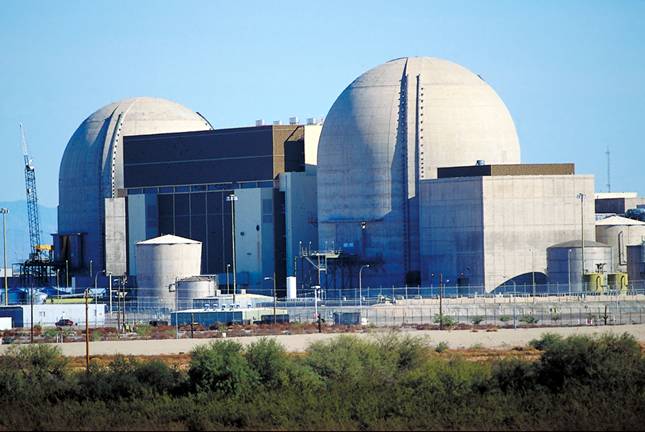
Nuclear power plant. Arizona USA
Metallurgical industry.
The metallurgical industry produces ferrous and non-ferrous metals. Ferrous metallurgy products are iron alloys (cast iron and various grades of steel), nonferrous - other metals and their alloys.
Metals are one of the main types of construction materials. Many components are used to make metal. First of all, it is ore (main raw material), fuel, various auxiliary materials. Metal production is a complex multi-stage process. Metallurgy is an extremely material and capitalist industry. Since the 90s. in the developed countries of the West, almost all steel is produced in oxygen converters and electric furnaces. Direct reduction of iron with | More than 40 million tons of steel are produced in metallized pellets in the world.
Ferrous metallurgy.
In the first half of the twentieth century. mining of iron ore geographically coincided with the main areas of iron and steel smelting and was concentrated mainly in the developed countries of Europe and North America... The exceptions were countries in which iron ore deposits were absent or until then depleted (for example, Germany, Great Britain). Over time, there has been a gradual shift in iron ore mining to new regions of the world, primarily to developing countries, as new large deposits and even whole pools of iron ores. The technical progress of sea transport also played a significant role in the reorientation of ferrous metallurgy to a new resource base, which led to a sharp decline in the cost of transporting ore. Many countries are forced to significantly reduce or completely stop mining their own ore (Great Britain, Germany, France, Spain, USA). Other countries, on the contrary, began to rapidly increase the rate of extraction of iron ore with the aim of its further export (Brazil, Australia).
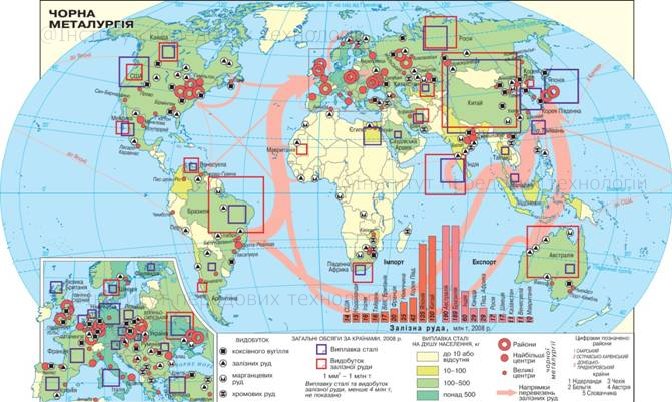
Ferrous metallurgy
At the beginning of the XXI century, more iron ore is mined in China, Brazil and Australia.
The so-called "Iron Ore Triangle" in the state of Minas Gerais and the Serra dos Carajas basin in the state of Para, in Australia - the Hammersley and Intern Dindale basins in the far north-west of the country have become major regions for the extraction of iron ore in Brazil. The iron ore industry is undergoing rapid development in China and India. China extracts ore for its own needs, and India - for its own needs and for export. Traditionally, a significant amount of iron ore is mined in Sweden and some African countries (South Africa, Mauritania, Liberia). 1/2 of the ore mined enters the world market, while 4/5 is transported by sea.
The largest exporters of ore are Brazil and Australia (40%), India, Canada, South Africa, Sweden, Liberia, Venezuela, Mauritania. Large importers - Japan, European countries (Germany, Belgium? Luxembourg, France, Italy, Great Britain, Poland, Czech Republic, Slovakia), USA. Japan gets iron ore from Australia, Brazil, India, South Africa; Germany - from Brazil, Sweden, Canada; USA - from Canada, Liberia, Venezuela.
The world's leading producers of coke are China, the USA, some European countries, Ukraine, and Russia. Coke is usually produced where it is used.
For the production of high-quality steel or steel with desired properties, alloy metals are widely used. The most popular alloyed metals are molybdenum, tungsten, manganese, chromium, nickel, titanium. More than half of molybdenum ores are mined in the USA, 2/5 of tungsten ores - in China. World production of manganese ores is concentrated in South Africa, Australia, Brazil, Gabon, India, Ukraine, Kazakhstan, Georgia. Chromites are mined in South Africa, Kazakhstan, Iran, Turkey, India, Zimbabwe, Finland, Brazil, Albania, and the Philippines.
Iron and steel production at mills full cycle traditionally gravitates towards fuels and raw materials. At the same time, the role of transport and the consumer increases.
The level of development of ferrous metallurgy in the country can be drawn from the following indicators:
- steel production per capita. The world leaders in this indicator are Luxembourg (2-3 tons, this country is called the "Duchy of Steel"), Belgium (1200 kg), Czech Republic, Slovakia, South Korea (950 kg each), Japan (830 kg);
- the ratio of the production of iron and steel. The significant prevalence of steel volumes over pig iron volumes testifies to the high level of development of ferrous metallurgy. Particularly high-quality steel is usually produced from scrap. Therefore, countries do not need to establish large-scale production of pig iron, but can process domestic and imported scrap.
In recent years, there has been a tendency in developed countries to develop small rolling mills. The initial stages of pig iron production (“Dirty Metallurgy”) are being pushed out to developing countries. Since the 70s of the twentieth century. distribution of domainless ("coke-free") metallurgy - "Midrex"
Ferrous metallurgy is characterized by large, full-cycle plants. The powerful ones are located in Fukuyama, Mizushima, Kasimi (Japan)? Baltimore, Trenton, Buffalo, Cleveland (USA)? Magnitogorsk, Lipetsk, Nizhny Tagil (Russia)? Dortmund, Duisburg (Germany)? Kryvyi Rih (Ukraine).
At the beginning of the XXI century, such major companies in the ferrous metallurgy were operating: Arcelor SA (Luxembourg, France, Spain), Nippon Steel (Japan), International Table Group, Nykor, USH-United Steps Table (USA ).

At a metallurgical enterprise
Non-ferrous metallurgy.
For the production of heavy non-ferrous metals, full-cycle plants are usually needed. Raw materials and energy factors have a decisive influence on the location of such production. Only specialized enterprises for the refining of heavy metals (for example, copper) are attracted to the consumer.
The stages of non-ferrous metal production are almost always geographically separated. Is the location of the production of semi-finished products (for example, the production of alumina in the aluminum industry) determined by raw materials and energy factors? the metal (aluminum) itself - the availability of cheap electricity? rental - by the presence of the consumer.
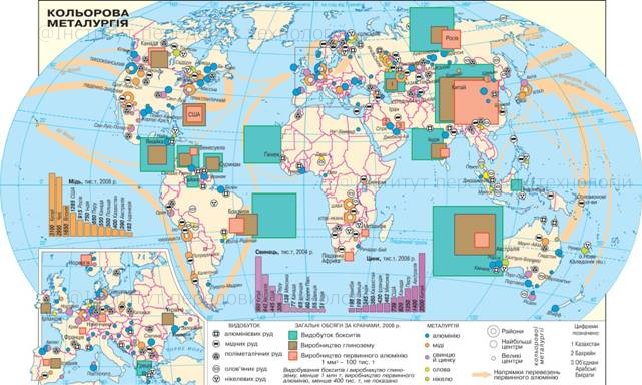
Non-ferrous metallurgy
V last years the geography of non-ferrous metallurgy has undergone changes. Gradually, the “centers of gravity” of this industry shifted to developing countries. These countries have significant reserves of raw materials for non-ferrous metallurgy, strengthen their own energy base and need non-ferrous metals.
The aluminum industry is an important branch of non-ferrous metallurgy. Aluminum is characterized by lightness, strength, high electrical conductivity, thermal conductivity, corrosion resistance, which allows it to be used almost everywhere. Thanks to these properties, aluminum is called the "king of non-ferrous metals".
The raw material for aluminum production in most countries is bauxite. About 85% of their reserves are concentrated in the laterite weathering crust, in the equatorial zone. More bauxite is mined in Australia, Guinea, Brazil, and Jamaica. They, as well as the USA, Russia, China, Canada, have become world leaders in the production of alumina. Russia, the USA have little bauxite, in Canada they are absent. Here production is based on imported raw materials.
In Russia, nepheline is also a raw material of aluminum. European countries are gradually phasing out bauxite mining. The role of large exporters of alumina is played by Australia (1/3 of world production), Guinea, Jamaica.
The main areas of use of aluminum are aircraft and rocketry, food industry (packaging), electric power industry (wire).
At the beginning of the XXI century, the largest companies in the aluminum industry are Alcoa (USA), Alcan (Canada), Peshinet (France), Basic Element (Russia).
The second most important branch of the world non-ferrous metallurgy is the copper industry. Copper has good electrical and thermal conductivity. This area is characterized by the territorial division of production stages. The higher the stage of processing, the less its share falls on the countries that are developing.
Developing countries - Indonesia, China, the Philippines in Asia - play a significant role in the production of copper ore concentrate? Zambia, Democratic Republic Congo in Africa? Chile, Peru, Mexico in Latin America? Papua New Guinea in Oceania. Among the developed countries, the USA, Canada, Australia and Poland have significant reserves of copper ores. Russia and Kazakhstan are rich in copper ores. These countries are also among the world leaders in the production of copper concentrate.
In addition to the listed countries (this does not include Papua New Guinea), the world's largest producers of blister copper (metal content 95%) are also Japan, Germany, and refined copper (metal content 99.9%) - Belgium, South Korea. No refined copper is produced in the Democratic Republic of the Congo. She sends all the blister copper to Belgium for processing.
The main consumers of copper are the electrical engineering and electronics industries. More copper is used by developed countries and some developing countries (China, South Korea, Brazil, India). Japan, Germany, the USA, China lack their own copper, so they import it.
The production of zinc and lead is traditionally focused on raw materials, as the largest producers are Australia, China, Canada, the United States, Peru and Mexico, which own the largest reserves of polymetallic ores. The largest amounts of lead and zinc are used in developed countries (USA, Japan, Germany) and some developing countries (China).
The main area of zinc consumption is the automotive industry. 60% of lead is also used in the automotive industry, the rest in the chemical industry.
Nickel production is developed in Canada (25% of world production), Russia (20%), Australia and New Caledonia. At the end of the twentieth century. so far countries have joined Cuba, the Dominican Republic, the Philippines. The main sphere of use of nickel is ferrous metallurgy - alloying and coating of alloys.
The world's largest tin producers are the countries of Southeast Asia and Latin America. More tin is used in sign making, as well as in electrical engineering and electronics.
The production of silver and gold is largely dispersed. Silver mining since the 15th-16th centuries. the palm was won by the Latin American countries (Mexico, Peru, Chile, Bolivia). The geography of gold mining is wider. Over 100 years large manufacturer gold is South Africa. Many gold is mined in African countries (for example, in Ghana), as well as in Latin America, North America and Australia. A significant amount of gold is mined in Russia and Uzbekistan.
Today, a significant part of silver and gold are mined not from their own deposits, but in parallel with other metals. Although the bulk of gold is provided by primary deposits (“gold veins”), the role of placer deposits is increasing. Almost 2/3 of silver is used in photochemistry, the rest is used in electrical engineering, electronics, jewelry industry, as well as for the production of coins and medals. Most of the gold goes to the production of bars and coins. Significantly smaller volumes of its consumption in the jewelry industry (about 300 tons per year) and electronics.
Of all the gold that mankind now possesses (120,000 tons), 2/3 must be of Latin American origin.
The mining of diamonds, another valuable and semi-precious stone, is classified as nonferrous metallurgy. Traditionally, the world leaders in diamond mining are African countries (South Africa, Namibia, Botswana, Angola, Democratic Republic of the Congo). In the second half of the twentieth century. large-scale diamond mining in the beginning of the USSR was continued by Russia), and at the end of the twentieth century. - Australia.
Of the 94 million carats of mined diamonds, more than half are used in the production of tools (cutting, polishing), the rest in the jewelry industry. Almost 3/4 of the diamonds used are artificial. There are rich traditions of cutting gem-quality diamonds in India, the Netherlands, Belgium, Israel.
The world diamond market is characterized by the presence of one buyer - the De Beers company (South Africa). Other diamond mining companies, in order to sell their goods, must conclude an appropriate contract with it.
Mechanical engineering of the world.
The mechanical engineering of the world is the leading industry, the share of which in terms of value is about 1/3 of the world's industrial production. It largely determines the general directions of scientific and technological progress. The end product of the industry is equipment (more than 1 million varieties) for all sectors of the economy without exception. Mechanical engineering also works to meet the needs of the individual user.
Great Britain is quite rightly called the "homeland" of mechanical engineering. This industry began to develop here at the end of the 18th century. At the beginning of the 19th century. mechanical engineering began to spread in Western Europe (Netherlands, France, Germany) and the USA, in late XIX v. - In the countries of Central and of Eastern Europe, Latin America, in the Russian Empire, and at the beginning of the twentieth century. - Around the world.
The location of enterprises in various branches of mechanical engineering is influenced by the following factors: the level of development of science, the availability of labor resources (in particular qualified), raw materials (construction materials, primarily metal), and the consumer. Specialization and cooperation also play a significant role.
Since any machine is manufactured by assembling (assembling) from a large number of parts, mechanical engineering is technologically divided into at least two stages: production of complete parts and compilation of finished products from complete parts. The production of modern assembly parts, assemblies and mechanisms is science-intensive, technologically complex and only developed countries can do it. Machines can be made from completing parts also in countries with a middle level of development. Here it is enough to use labor resources with secondary basic education, trained in certain operations. It was this fact that influenced the spread of mechanical engineering in the second half of the twentieth century.
Today, developed countries are the world leaders in the field of mechanical engineering. The USA, Japan, Germany produce practically the entire known range of engineering products. At the same time, the United States specializes in the production of powerful supercomputers (servers) and aerospace technology; Japan - sophisticated home appliances, electronics, automobiles, ships, industrial equipment and robotics; Germany - industrial equipment (primarily electrical), cars, printing equipment. France, Great Britain, Italy also produce a significant amount of engineering products. Recently, South Korea has joined the world leaders in mechanical engineering. Small countries of Western Europe have insignificant volumes of production of engineering products. However, given its high quality, they are able to control a significant market share. For example, Switzerland specializes in the production of high-precision metal-cutting machine tools, watches, equipment for mills; Austria produces mining machinery and equipment for the pulp and paper industry; Netherlands - electrical equipment; Denmark - industrial refrigerators and sea fishing vessels; Sweden - industrial electrical engineering and automobiles, Finland - floating drilling platforms and cell phones.
The first developing region in which mechanical engineering appeared was Latin America... This industry was created here for the direct participation of the developed and was aimed primarily at meeting the needs of the region itself. Right now in large countries the region is practically all well-known fields of mechanical engineering. In addition, some countries (formerly Mexico and Brazil) began to increase the production of products for export.
In the countries of East and Southeast Asia, the development of mechanical engineering began only in the 60s of the twentieth century. It was also created with the help of developed countries, but was export-oriented. Over the past decades, South Korea, Taiwan, Malaysia, Thailand, the Philippines, Indonesia have become powerful manufacturers of household appliances, electronics, communications, as well as cars and other vehicles. In the 80s of the twentieth century. mechanical engineering has spread to China, India, Turkey, Iran and the "most prepared" African countries - Nigeria, Egypt, Morocco, Algeria.
The level of development of mechanical engineering in a particular country can be judged by the indicators of the volume of exports of the industry's products (in billion US dollars) and the share of the industry's products in the country's exports. Developed countries are world leaders in absolute terms. USA, Germany, Japan - traditionally largest exporters engineering products. They are followed by the countries of Europe and Canada. In the 80s of the twentieth century. the leaders were South Korea, Singapore, Hong Kong, Taiwan, in the 90s - China, Mexico, Malaysia.
In terms of the share of products in exports, the leaders are the United States and European countries (formerly Western European ones - Germany, Great Britain, Sweden, some countries of Central-Eastern Europe - the Czech Republic and Hungary). In the 80s of the twentieth century. Japan came out on top. Subsequently, the leaders were joined by South Korea, Taiwan, Singapore, Malaysia, the Philippines. This is explained by the fact that in the 70s and 80s whole branches of the world mechanical engineering moved to these countries.
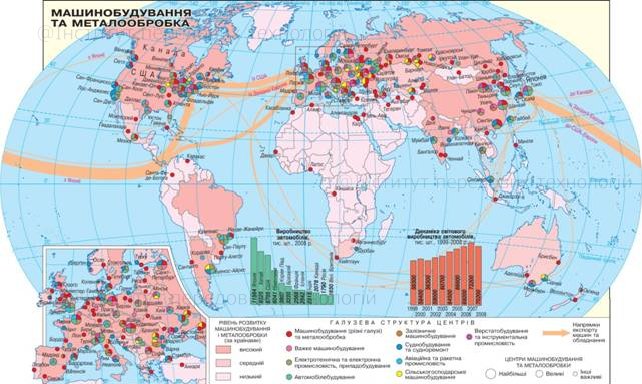
Mechanical engineering and metalworking
The production of metal-cutting machines and metal-working equipment is one of the leading branches of the world mechanical engineering, the geography of which has undergone dramatic changes over the past half century. If earlier such countries as the USA, Germany, Switzerland, Italy were in the lead, then later the USA almost completely lost to Japan, Taiwan, China. Germany, Switzerland, Italy retained their positions. Japan and Germany specializing in the production of complex machine tools and powerful flow lines, Switzerland - high-precision machine tools, Italy, Taiwan, China - other modern machine tools. The share of exported products of the machine tool industry is the highest in Switzerland (90%), Taiwan and Germany (2/3). Japan and Sweden are powerful manufacturers of robots and photographic equipment.
Among the branches of transport engineering automotive industry takes leading positions. It originated at the end of the 19th century. in Europe, and subsequently quickly penetrated the United States.
The invention and implementation of the world's first conveyor belt at G. Ford's plant (1913) became a revolution in the automotive industry. The division of labor into a number of highly specialized stages made it possible to reduce the assembly time for one car from 12.5 hours to 93 minutes, i.e. almost 8 times. At the same plant, black paint began to be widely used, which dried faster than others.
Japan's success in the global automotive market is explained by the fact that it has relied on the production of economical small cars. At the time, this fact coincided with the world oil crisis, so efficiency turned into important factor sales of products.
In the first half of the twentieth century. in the United States produced up to 80% of all cars in the world. In the 50s of the twentieth century. the automotive industry spread to most European and Latin American countries, and in the 70s to Japan. At the end of the twentieth century. the automotive industry has spread to all regions of the world.
At the turn of the XX-XXI centuries. The United States has regained its leadership in the global automotive industry. Japan, Germany, France, Italy, Great Britain, Canada retain significant production volumes. South Korea, Spain, Mexico, Brazil sharply increased the production of cars. The automotive industry is undergoing rapid progress in China and India.
The leaders in terms of car sales are the American market (16-17 million new cars and about 50 million used cars are sold annually), European (14-15 million) and Japanese (4-4.5 million). The Chinese and Indian automotive markets are growing rapidly.
The largest automotive companies in the world: American General Motors (owns trademarks or large stakes in Chevrolet, Pontiac, Oldsmobil, Buick, Cadillac, Saturn, Opel / Vauxhall, SAAB-Scanue, Daewoo Motrs) and Ford Motors (Mercury, Lincoln, Aston Martin, Land Rover, Jaguar, Volvo, Mazda), German-American Daimler Chrysler (Dodge, Plymouth, Jeep, Smart, Mitsubishi Motors, Hyundai Motors, Kia Motors), German Volkswagen (Audi, SEAT, Skoda, Bentley, Bugatti, Lamborghini) and BMW (Mini, Rolls Royce), Japanese Toyota Motors and Honda, French Renault and Peugeot, as well as the Italian Fiat.
For a long time, the leading positions in the world non-military shipbuilding were occupied by European countries: first the Netherlands, then Great Britain. Even in the middle of the twentieth century. almost 1/2 of all sea vessels left the stocks of British shipyards (in particular, Glasgow and Belfast. In subsequent years, the main center of world shipbuilding moved to East Asia. Today, more than 3/4 of world sea vessels are produced at the shipyards of South Korea and Japan. China and Taiwan are producing ships, while European countries, including Great Britain, on the contrary, are cutting back.

Hovercraft
Aircraft engineering- Strategic and promising mechanical engineering industry. In the 30s of the twentieth century, before the Second World War, the leadership in the production of aircraft and missiles belonged to Germany. In the second half of the twentieth century. its place was taken by the USA and the USSR. At the same time, the United States has successfully mastered the production of the entire spectrum of aircraft missiles - from civil aircraft and helicopters to powerful ballistic missiles, while the USSR focused on the production of military equipment. Now the US share of the world civil aircraft market is almost 60%, the share of the single European company Europen Airbus, which united the capitals of companies from France, Germany, Great Britain, Italy - 40%, Russia - about 1%.
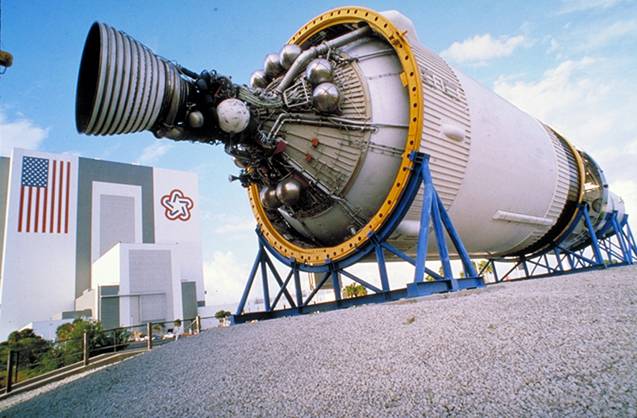
Space Center. Kennedy at Cape Canaveral. Florida, USA
The world's largest air rocket companies are the American Boeing McDonel Douglas, Lockheed Martin, General Deinemics, United Technologies and European Airbus.
For the production of cars, locomotives (rolling stock), the United States, France, Germany, the Czech Republic, Japan, and Russia are distinguished. The world leaders in the production of tractors and agricultural machinery are developed countries (USA, Germany, France, Japan) and large developing countries (India, China, Brazil).
Power engineering, electrical engineering, instrument making, radio engineering and electronics are important branches of the world mechanical engineering. These industries produce sophisticated types of equipment. Today, the world leaders in the production of televisions, radios, audio and video recorders, personal computers, mobile phones are the countries of East and Southeast Asia, as well as Latin America, Central and Eastern Europe. More cameras are produced by Hong Kong, Japan, China, watches - by Hong Kong, Japan, Switzerland.
More power equipment and industrial electrical engineering are manufactured by developed countries. Among the large companies, the following are the most powerful: American General Electric, Westinghouse Electric, German Siemens, AEG-Telefunken, Bosch, Japanese Mitsubishi, British Marconi, Dutch Philips, Swiss-Swedish Asea-Brown-Boveri. The largest companies producing household electrical appliances and electronics are the same companies, as well as the Japanese Sony, Matsushita, Hitachi, Toshiba, Shivaki, JVC, Sharp, Sanyo , Citizen, South Korean Samsung, LG, Daewoo, Italian Merloni, Olivetti, French Tefal, etc. The largest personal computer manufacturers are the American companies International Business Meshins, Intel "," Apple "," Micron Technology "," Hewlett Pekard "," Epson ".
Chemical industry.
At the present stage, one of the most important industries is the chemical industry. At the turn of the XVIII-XIX centuries. in the chemical industry they produced meadows, acids, soda, ammonia, and some types of mineral fertilizers. In the second half of the XIX century. they were supplemented by plastics, chemical fibers, general mechanical rubber goods from natural rubber. The real flourishing of the chemical industry falls on the twentieth century. At the beginning of the twentieth century. the basis of the world chemical industry was the production of basic chemistry (inorganic), in the middle of the century it was replaced by the chemistry of organic synthesis (together with the production of polymer materials), and at the end - fine chemistry (pharmaceutical, perfumery and cosmetic, household, photochemistry, biochemistry). If at first thermoactive plastics predominated in the total volume of plastics production, then later they were replaced by thermoplastics (for example, polyethylene), artificial fibers were eventually replaced by synthetic ones, and natural rubber by synthetic ones.
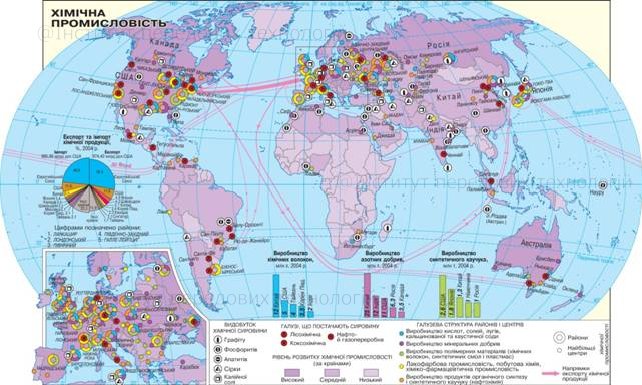
Chemical industry
Now the chemical industry, along with mechanical engineering, is the locomotive of world scientific and technological progress. It is in this area that a large proportion of scientific discoveries... Many types of chemical products are significantly superior in quality to their natural counterparts, successfully replacing them.
The development of chemical technologies has also determined the main types of raw materials used. First of all, this concerns the chemistry of organic synthesis. If by the middle of the twentieth century. The main chemical raw materials for this group of industries were vegetable raw materials and coal, then later they were almost completely replaced by oil and natural gas. Accordingly, industries such as oil and gas chemistry began to develop intensively.
Developed countries are the undisputed leaders in terms of the level of development of the chemical industry. They not only produce the most chemical products, but also have a modern structure. For example, most developed countries produce less sulfuric acid and fertilizers than plastics. In terms of the cost of manufactured products, the first places in these countries are occupied by the fine chemicals industry.
Due to the great variety chemical products formed the specialization of certain countries in the chemical industry. All over the crane, only the US is capable of producing all types of chemical products in large volumes. Petrochemistry is well developed in Japan. Germany specializes in the production of varnishes and paints. France produces synthetic rubber and industrial rubber goods, Great Britain - synthetic detergents, the Netherlands - plastics, Belgium - plastics, inorganic acids and salts, Switzerland and Hungary - pharmaceuticals, Sweden and Norway - forestry and electrochemistry products. However, this does not mean that other types of products are not produced in the listed countries. Some "newly industrialized countries" (South Korea, Taiwan) are rapidly increasing the production of plastics and chemical fibers. In China and India, basic chemical products prevail. In countries with significant reserves of oil and gas (Iran, Saudi Arabia, Kuwait, United Arab Emirates, Qatar, Indonesia, Algeria, Libya, Egypt, Mexico, Venezuela), products of organic synthesis chemistry prevail. Russia maintains significant volumes of production of basic chemicals.
In terms of production and export of native sulfur, the leading positions in the world are occupied by the USA and Mexico. France and Canada extract more sulfur from gas condensate. More phosphorites are mined and exported by the USA, Morocco (1/3 of world exports), Algeria, Tunisia, apatites - Russia, potassium salts - Canada, USA, Russia, Germany.
In terms of production of sulfuric acid, soda ash and caustic soda, developed countries (USA, Japan, France, Germany), large developing countries (China, India, Mexico, Brazil, Indonesia) and Russia traditionally lead.
The largest amount of mineral fertilizers (in terms of active substance) is produced in developed countries and Russia, as well as in countries, developing countries with large populations (China, India, Indonesia, Pakistan). The same countries have taken a course to increase the production of mineral fertilizers, so they have set themselves the task of providing themselves with their own food products.
In terms of production of plastics, chemical fibers, synthetic rubber and polymer products, the USA, Japan and European countries traditionally lead. In the 80-90s of the twentieth century. they were joined by South Korea, Taiwan and major developing countries. In the structure of plastics production, more than 9/10 falls on thermoplastics, in the structure of production of chemical fibers - almost 91% on synthetic fibers.
The world's largest chemical companies producing products of basic chemistry and organic synthesis chemistry are the American DuPont de Nemours, Union Carbide, Dow Chemicalcl, Monsanto, the British International Chemical Industries, German BASF, Bayer ", Franco-German" Aventis ", Italian" Montedison ".
The most powerful companies for the production of tires and rubber-technical products are the American Goodyear Tire and Rubber, Bridgestone, the French Michelin, the Italian Pirelli, the British Dunlop. In terms of production of fine chemicals and cosmetic products, the palm belongs to Procter & Hembel, Johnson & Johnson, Colgate-Palmolive (USA), Benkizer (Germany, Italy, USA), Henkel (Germany ), "Cassance" (Great Britain). More pharmaceuticals are produced by Pfizer, Bristol Myers Squibb, ICN Pharmaceuticals, Shereng Plow, Yesen-Silag (USA), Roche (Switzerland), Bayer (Germany), Sanofi (France), Glexo Smith Kline (Great Britain), photochemistry products - Eastman Kodak (USA), Fuji, Konica-Minolta (Japan).
Timber and woodworking industry- One of the old industries. People made dwellings from wood, made household items, vehicles... With the development of science and technology, wood has given way to other construction materials - metal, plastics, so the scope of its use has significantly narrowed. Today, wood is used to produce building materials, furniture, paper, cardboard, some chemicals and household items.
In the second half of the twentieth century. the timber industry under the influence of scientific and technological progress has changed significantly: there was an increase in the quality of products, a decrease in its cost.
Nowadays, from 1 m? much more wood is produced than before; the amount of waste has also decreased. The geography of the industry has changed. If earlier the harvesting and processing of wood was concentrated in developed countries or in the northern forest belt, then in the last quarter of the twentieth century. more than half of the timber has already been harvested in developing countries, or in the southern forest belt. Accordingly, the raw materials have changed: developed countries are characterized mainly by coniferous forests, while developing countries are characterized by broad-leaved forests. In the context of the globalization of the world economy, international companies have moved a significant part of their production base to the rich forest resources of the developing country. However, at the present stage, the following pattern is typical for the timber industry: the higher the degree of wood processing, the greater the share of developed countries on the market. This means that developing countries have become only suppliers of raw materials, and not producers of final products.
Now the world is harvesting about 3.3 billion cubic meters? wood. Moreover, more than 1/2 is used as fuel (firewood). The rest are commercial timber for processing. The depth of wood processing in different countries is not the same. In the USA, Canada, most European countries, Japan is close to 100%. That is, from 1 m? raw wood is produced about 1 m? useful products. For most developing countries, this figure ranges from 20-30%. At the same time: one part of the harvested wood is used for firewood, and the second is almost completely exported to developed countries, where it is processed. For example, Japanese companies harvesting timber in Southeast Asian countries usually uproot trees. The whole tree is used for processing - roots, branches, leaves.
In order to improve production efficiency, most of the timber is harvested in those regions where it is rapidly recovering. In developed countries, these are primarily regions with moderate maritime climate: north-east and north-west of the USA, north-west of Canada, the whole territory of Northern Europe. In developing countries, timber is harvested in the wet evergreen zone equatorial forests(Indonesia, Malaysia, Democratic Republic of the Congo, Cameroon, southern Nigeria, Brazil, Colombia, Venezuela, Peru, Bolivia).
The developed countries (USA, Canada, Sweden, Finland, Germany, France, Japan), as well as Russia, retain the leading positions in terms of sawn timber production. In recent years, sawnwood production has increased significantly in some developing countries (China, India, Indonesia, Brazil, Chile).
Woodworking industry small countries Europe is narrowly specialized in the production of individual products. For example, in terms of production of plywood and fiberboard, countries such as Austria and Portugal occupy leading places in the world. More furniture in the world is produced by developed countries. Half a century ago, they were made exclusively from whole boards, now - from particle boards (chipboard). For the manufacture of expensive luxury furniture, chipboard is covered with a layer of natural wood (veneer) with a thickness of 2-3 mm. Brazil supplies about 4/5 of the furniture veneer made of valuable species of tropical wood to the world market. The deep traditions of furniture production have been preserved in Italy. High quality furniture from its own wood (beech, hornbeam) is produced by Romania.
The most important types of timber industry products are cellulose, paper, cardboard. In terms of paper production, the leading places in the world are traditionally occupied by developed countries (USA, Japan, Canada, Germany, Nordic countries). Paper production is rapidly increasing in some developing countries (China, Brazil, India, Mexico). In China, a large proportion of paper is produced from rice straw. In the Brazilian Amazon, at the mouth of the Zhare River, there is a powerful floating pulp and paper mill built in Japan.
In terms of paper production per capita, the world leaders are the Nordic countries, Canada, Austria. At the same time, Canada specializes in the production of newsprint, Finland, Sweden, Norway - office paper. All developed countries produce a lot of packaging paper.
The main types of wood chemistry products are charcoal, hydrolytic alcohol, turpentine, and fodder yeast. The intensification of the harvesting of tropical timber influenced the formation of such industries as the collection of resin, wax, and some types of oils.
Light industry.
Light industry - a set of industries whose enterprises manufacture items popular consumption... It belongs to the oldest branches of the economy.
Main industries light industry:
- textile;
- sewing;
- leather and shoe;
- fur
Man has mastered the processing of textile fibers, leather and animal fur for the production of clothing for a long time. Over time, new types of raw materials (chemical fibers, artificial leather) began to be used, fashion gradually influenced production, and the quality of products improved. The organizational structure of the light industry has also changed: if earlier clothes and shoes were made by small workshops, now they mainly work large companies... Fashion houses began to play an important role, developing new models of clothing and footwear, then replicating large companies. In the second half of the twentieth century. a significant part of the production base of these companies has moved from developed countries to crane, developing, that is, closer to raw materials and cheap labor. Today, developed countries produce elite and expensive products.
Large centers of fashion are traditionally Paris, Milan, London, New York.
The leading industry in the world textile industry is cotton, followed by silk, woolen, linen, hemp-jute. Of the total amount of textile raw materials that are used, about 2/3 is accounted for by cotton, 1/5 - by chemical fibers (mainly synthetic), 1/10 - by wool, slightly more than 1.5% - by fiber flax.

Modern factory for the production of synthetic fibers
In the first half of the twentieth century. world leaders in the production of all types of fabrics were developed countries, as well as China, India, the USSR. In the second half of the twentieth century. much of the textile industry has moved to developing countries. South Korea, Taiwan, Hong Kong, the countries of Southeast Asia, Pakistan, Turkey, Brazil, Mexico, Syria, Egypt, Colombia have sharply strengthened their positions in the production of cotton, silk, woolen fabrics. In developed countries, on the contrary, the production of fabrics has been steadily declining. In this regard, the regions of these countries, which traditionally had a high level of development of the textile industry, experienced a deep crisis. Of all the industries, only hemp-jute, in general, is focused on raw materials, has retained its territorial structure. More linen fabrics are produced in Russia and other European countries (France, Belgium, Germany, Poland, Czech Republic, Hungary, Ukraine), jute fabrics - in India and Bangladesh.
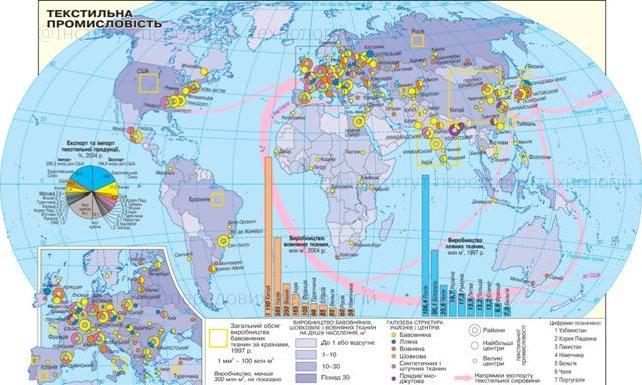
Textile promise
In the structure of production of fabrics by type, cotton usually predominates, but in the USA, Japan, South Korea - silk. Great Britain, Italy, Belgium are famous all over the world for their fine cloth (high quality woolen fabrics), lace - Belgium, Germany, France, curtains - Germany.
Now the overwhelming majority of enterprises in the garment industry have moved from developed countries to developing countries, where they produce the bulk of linen, outerwear, and carpets.
Clothing factories are closely linked by cooperation with a large number of enterprises in various sectors of agriculture, industry, and services. So, a new model of jeans can be developed in New York, the fabric is made in Pakistan, and its cutting and sewing can be carried out in Malta. For the same reason, a significant number of tropical countries - Indonesia, Thailand, Malaysia, Vietnam, Bangladesh, Pakistan - are the world's leading manufacturers of winter outerwear.
Changes in the spatial differentiation of the world textile and clothing industry in the second half of the twentieth century. determined the main directions of modern world trade in textiles.
The largest exporters of textiles were Asian countries, to a lesser extent - European countries and the United States, importers - developed countries and, above all, the United States. The United States exports mainly textile raw materials (1/3 of the world exports of cotton fiber), and imports finished products from Hong Kong and Taiwan.
A gradual shift from developed countries to developing countries, the shoe and leather industry has also experienced. If in the first half of the twentieth century. the vast majority of shoes were made in Italy, the USA, France, Germany, Great Britain, but in recent decades only Italy has retained its position (350-360 million pairs per year). The rest of the countries ousted China (over 500 thousand pairs), India, Brazil (200 million pairs each), Spain, Portugal, Poland.
More shoes per capita are produced in Italy and the Czech Republic (6 pairs per person per year). In Italy, almost half of the shoes are made by small private workshops, in which they mainly use manual labor. In addition, Italy specializes in the production of soles.
The largest world exporters of footwear are Italy, Brazil, importers - the United States, Japan, Germany, France, Great Britain.
Today the fur industry is in decline. This is due to the significant strengthening of the wildlife protection movement. For the same reason, and to reduce the cost of finished products, most modern fur products are made from the fur of animals grown in cages.
Major suppliers of mink skins to the world market are Finland, silver foxes - Denmark, ordinary fur products - Greece, high quality fur products - Italy, Russia, Canada.
Sheepskin products, including sheepskin coats, are famous for countries with developed sheep breeding - Spain, Italy, Turkey, Iran, Afghanistan, South Africa, Australia, New Zealand, Argentina, Uruguay.
- ← § 16 World economy in the era of scientific and technological revolution, the impact on the sectoral structure and territorial organization of production.
- § 18 World agriculture: significance, intra-sectoral structure, inter-sectoral relations, agrarian relations. Largest agricultural areas. →
Industry - a branch of production that includes the processing of raw materials, the development of mineral resources, the creation of means of production and consumer goods. This is the main branch of the sphere of material production. Industry produces: means of production, consumer goods, processes agricultural raw materials, ensures the operation of all sectors of the economy, determines the country's defense power, ensures scientific and technological progress.
An industry sector is a set of organizations, enterprises, institutions that produce homogeneous goods and services, using the same type of technology, satisfying needs that are similar in nature.
Classification of industries - a list of industries approved in accordance with the established procedure, providing comparability of indicators for planning, accounting and analysis of industrial development.
There are several classifications:
Division of industry into groups A and B: industry of group A (means of production), industry of group B (commodities).
Division of the industry into heavy and light.
By the nature of the impact on the subject, the industry is divided into two groups: extractive (extraction and preparation of raw materials) and processing (processing of raw materials and production of finished products).
Sectoral classification: electric power industry, fuel industry, ferrous metallurgy, non-ferrous metallurgy, chemical industry, mechanical engineering and metalworking, timber industry, building materials industry, light industry, food industry.
The sectoral structure of industry characterizes the level of industrial and technical development of the country, the degree of its economic independence and the level of productivity of social labor.
When analyzing the sectoral structure of an industry, it is advisable to consider not only its individual sectors, but also groups of sectors, which are intersectoral complexes.
An industrial complex is understood as a set of certain groups of industries, which are characterized by the release of similar (related) products or the performance of works (services).
At present, the industries are united into the following complexes: fuel and energy, metallurgical, chemical, timber industry, machine-building, agro-industrial, construction complex, military-industrial (sometimes isolated separately).
The fuel and energy complex (FEC) includes the fuel industry (coal, gas, oil, shale industries) and electric power (hydropower, thermal, nuclear, etc.). All these sectors are united by a common goal - to meet the needs of the national economy in fuel, heat, and electricity.
The metallurgical complex (MK) is an integrated system of ferrous and non-ferrous metallurgy industries.
The machine-building complex is a combination of machine-building, metalworking and repair industries. The leading branches of the complex are general mechanical engineering, electrical engineering and radio electronics, transport engineering, as well as the production of computers.
The chemical complex is an integrated system of the chemical and petrochemical industry.
The timber industry complex is an integrated system of forestry, woodworking, pulp and paper and wood chemical industries.
Agro-industrial complex (AIC) can be considered as a set of technologically and economically related links National economy, the end result of which is the most complete satisfaction of the needs of the population for food and non-food products produced from agricultural raw materials. It includes agriculture (crop production, animal husbandry), as well as light and food industries.
The construction complex includes a system of construction industries, an industry of building materials.
The military-industrial complex (MIC) is represented by industries and types of activity (primarily R&D) focused on meeting the needs of the Armed Forces.
The following enlarged industries were distinguished in OKONKh:
Power engineering
Fuel industry
Ferrous metallurgy
Non-ferrous metallurgy
Chemical and petrochemical industry
Mechanical engineering and metalworking
Forestry, woodworking and pulp and paper industries
Building materials industry
Glass and porcelain industry
Light industry
Food industry
Microbiological industry
Flour and cereals and feed industry
Medical industry
Printing industry.
Topic 1. Industries.
Questions to study:
1. Concept and classification of industries.
2. The economic state of the industries in Russia.
Literature:
1. Cheredanova L.N. "Fundamentals of Economics and Entrepreneurship"; textbook for primary prof. education; L.N. Cheredanova. - 2nd ed. - M .; "Publishing Center" Academy ", 2008 - p. 176.
2. Sergeev I.V. Enterprise economy: tutorial 2nd edition, revised and enlarged - M .: Finance and statistics, 2008 - 304s.
3. Volkova OI "Enterprise economy". M .: Infra - M: 2007
4. Gruzinov V.P., Gribov V.D. "Enterprise Economics" Moscow: 2009.
5. Gorfinkel V.L., Shvandar V.A. "Enterprise Economics" Moscow: "Unity" 2008
6. Zaitsev N.L. The economics of an industrial enterprise. Infra-M: 2007
7. Safronov N.A. Enterprise economy. Moscow: 2008
Introduction
Industry - leading industry of folk economic complex Russia, functioning along with other industries - agriculture, forestry, transport, communications, etc.
A significant part of GDP and gross value added is generated by industry. It provides expanded production across all sectors of the economy. It is in the industry that, first of all, research and development are implemented in the form of new technologies, equipment, devices, etc., ensuring the implementation of the achievements of scientific and technological revolution in the economic sector. The industry creates conditions for a more efficient use of material and labor resources, for achieving maximum results at minimum costs.
By the nature of the impact on the subject of labor, the industry is divided into extractive and manufacturing. The first is engaged in the extraction of minerals and other substances that nature presents to man, and the second is processing raw materials, materials into finished products.
The concept and classification of industries.
Modern industry consists of many industries, subsectors and types of production, interconnected with each other. The main features that distinguish one industry from another are:
· Economic purpose of manufactured products;
· The nature of consumed raw materials and materials;
· Technical base of production and technological processes;
· Professional staff. Separate industries differ on the same grounds.
At the same time, for the assignment of an enterprise to a particular industry, it is not necessary to have all the above characteristics. In economic practice, usually one characteristic is taken into account, which has a dominant value. For example, in the formation of the "mechanical engineering" industry, the common purpose of products is taken into account. All enterprises included in this industry produce mainly products used as instruments of labor and related to the means of production by the consumer. Merged into Food Industry enterprises, workshops and industries manufacture various types of products, which are mainly food and related to consumer goods. The basis of a business combination metallurgical industry the sign of the generality of the technological process is laid. The woodworking industry is based on the commonality of processed raw materials.
Naturally, the industry includes research and development organizations, which, although they do not produce specialized products, develop appropriate products, provide technological training, etc.
The formation of a branch of industry is conditioned by certain conditions, the most important of which are:
· The presence of a large enough market for the sale of this type of product .
(The insignificant demand for certain types of products does not allow the creation of enterprises that ensure efficient production and sale. In this case, it is preferable from an economic point of view to import these products, which is important from the point of view of the country's defense capability or economic security).
· Availability of reserves of appropriate natural resources.(First of all, this applies to such industries as coal, gas, oil and other single-product industries).
In economic theory and practice, the following main features are used that form the basis for the classification of industries:
· According to the economic purpose of the manufactured products;
· By the nature of the impact on the subject of labor;
· By the functional purpose of the product;
· By the level of monopolization of production;
· In terms of economic originality.
According to the grouping of industries
· on the economic purpose of their products , the entire industry is divided into two large groups of industries:
1. Group (A)- industries producing means of production (means of production include products intended for use in production as means and objects of labor. At the same time, part of the products of the light and food industries sent for further processing can be classified as objects of labor).
2. Group (B)- industries producing consumer goods (consumer goods include products intended directly for final consumption by the population).
· By the nature of the impact on objects of labor all branches of industry are subdivided into extractive and manufacturing. The enterprises of the extractive industries are directly involved in the extraction and procurement of natural mineral and biological raw materials. At the same time, there is no change in the properties of objects of labor. Extractive industries include coal, oil, shale, logging, mining, hydropower production, fishing and some.
· By functional purpose of products the entire industry is divided into branches that produce elements of fixed assets, circulating assets, and consumer goods. At the same time, if the industries producing elements of fixed assets and consumer goods produce final products, then the industries producing elements of working capital produce, as a rule, intermediate products, which subsequently undergo a certain processing.
· By the level of monopolization of production all industries are subdivided into completely competitive, monopolistic, monopolistic and oligopolistic.
Industries are completely competitive, consisting of a significant number of enterprises, each of which produces and supplies to the market goods that are perfect substitutes for competitors' goods. At the same time, the supply volume of each enterprise separately makes up an insignificant share of the total supply volume (no more than 1%) and, therefore, cannot affect the price prevailing in the market. Completely competitive industries are usually characterized by an unstable composition, since each enterprise has the ability to freely enter and exit the industry, regardless of market conditions.
Monopoly industry consists of only one enterprise producing and supplying the market for these products. Monopoly industries have the ability to control the volume of goods on the market, the price of the product, and prevent competitors from entering the market.
As a rule, the prevention of the appearance of competitors on the market is ensured by obtaining from the government exclusive rights to the production of these products (services), patents and copyrights to new products and technologies that create exclusive rights to their owners for the production and sale of these products, as well as a large amount investments necessary for competitors to enter the market (for example, although it is theoretically possible to imagine the creation of a corporation competing with Gazprom, providing gas pumping through parallel networks, it is practically impossible to realize this due to the huge amount of required investments).
Monopolistic Competition Industry characterized by the presence in its composition of a relatively large number of relatively small enterprises. These firms produce a variety of products, and although the product of each firm is specific, the consumer can easily find substitute products and switch his demand for them. The enterprises in the industry compete with each other and own a small (1 to 10%) market share. At the same time, the release of differentiated products provides them with a certain monopoly power and allows them to ignore the reaction of competitors when setting prices and output.
The oligopolistic industry is characterized by the fact that it may include a limited number of enterprises with a significant market share. The limited number of them leads to mutual dependence in establishing the volume of output and the price of a product. This ensures greater stability in market prices and in the volume of industry supply. An oligopoly is characterized by restrictions on the entry of new firms into the market.
The classification of industries on the basis of concentration of production and supply at individual enterprises allows the government to assess the market situation, develop measures to regulate the market and actively oppose monopolistic trends in industry.
· By economic identity the enterprises of the industry and production included in them are subdivided according to such criteria.
1. The production and non-production sphere of the national economy
Despite the transition of Ukraine to a new classification of types of economic activity, there is a division of the national economy (national economy) into spheres and industries, according to which the education and training of specialists takes place.
The labor of citizens of society is distributed among the branches of the national economy. The most important feature by which it is possible to determine to which industry the enterprise should be classified is the uniformity of the functions performed. Thus, branch of the national economy is a group of enterprises and organizations that perform functions that, in accordance with the classification, allow them to be assigned to one or another
group. (? T) TrsTsk __________
All industries on ^ dx ~ roles in the process of recovery are divided, first of all, into the sphere of material production and the non-production sphere. At the same time, the difference between material production and the non-production sphere is fundamental.
Material production- this is the sphere of application of the public pile for the production of material goods. The production of material goods is the basis of society. The products of labor in the sphere of material production form the material content of social wealth. That. the action of the productive forces of society on the substances and forces of nature for the appropriation of the results of this action, material goods in a form suitable for the consumer is the main feature of any material production, regardless of its social form. The process of material production determines the materialization of the pile, its materialization in individual products.
In the non-production sphere material benefits are not created, but useful activities are manifested in the form of services for society as a whole, as well as for the needs of the population. The services produced do not materialize because the beneficial effect is manifested only in the process of their production or implementation, and the consumption of services cannot be imagined outside this process.
The non-productive sphere includes the branches of government and services for the public and personal needs of the population (scientific activity, education, medical care, art, etc.). As already noted, the results of labor in the non-productive sphere are not material goods, but various socially necessary and useful services.
Enterprises in the sphere of material production, in turn, are classified by industry.
1. Classification of branches of material production

Social production is heterogeneous, therefore it includes several industries, the number and structure of which is constantly changing (due to the emergence of new types of industries, etc. for other reasons).
Material production branch is a group of enterprises that have a general nature of the products they produce and the production process.
Those. individual branches of the sphere of material production unite enterprises and organizations on the basis of the homogeneity of the functions performed by them or the homogeneity of the manufactured products.
According to the current classification of the Ministry of Statistics of Ukraine, the sphere of material production includes the following industries:
1. Industry;
2. Construction;
3. Agriculture;
4. Water management in terms of production activities;
5. Forestry;
6. Geology and exploration of subsoil in terms of deep exploration drilling for oil and natural gas;
7. Freight transport;
8. Communication in terms of servicing industrial enterprises;
9. Trade and catering;
10. Logistics support; 11. Harvesting;
12. Other types of activities in the sphere of material production. Since the production process includes all stages of reproduction
until the moment of consumption of products, then not only the first six industries in which material goods are produced and created (industry, construction, agriculture, water, forestry, geology and exploration of subsoil) belong to the production sphere. But the industries that ensure the delivery of the product to the consumer (freight transport, trade, logistics and procurement), as well as those that provide communication between the industries, also belong to the production sphere. Thus, these industries that provide storage, transportation, packaging, etc. to a corresponding extent increase the value of products created in industry and agriculture.
Let us consider in more detail each of the branches of material production.
The listed large branches of the sphere of material production, in turn, are subdivided into a number of branches and types of production.
Industry is the leading and largest branch of the national economy. Industry encompasses the extraction and procurement of material goods available in nature, and the further processing of material goods, both obtained by industry itself and produced in agriculture. I

That. the industry unites two sub-sectors:
Mining;
- processing.
The first is busy with the extraction of products of nature, which cannot be
made by man. Those. characteristic feature the extractive industry is that its object of labor already exists in nature (this is mining of PI - coal, oil, ore, etc. industries, and hunting, and fishing, and timber harvesting, etc.), while as a processing industry, the subject of labor is a product of previous labor. The second includes enterprises that process industrial and agricultural raw materials into a new product, as well as for the repair of industrial products.
Industry includes hundreds of thousands of large and small enterprises. Industrial enterprises and production associations are classified by type of production and industry.
Industry- is a set of industrial enterprises and production associations, homogeneous, first of all, according to the purpose of the products they produce.
Thus, the main feature of the classification by industry is the homogeneity of enterprises and associations in terms of their products. In some cases, the classification also uses the signs of the homogeneity of the processed raw materials (for example, cotton processing enterprises collectively represent the cotton industry) and homogeneity
3. Ferrous metallurgy;
4. Non-ferrous metallurgy;
5. Chemical and petrochemical industry;
6. Mechanical engineering and metalworking;
7. Forestry, woodworking and pulp and paper
industry;
8. Building materials industry;
9. Glass and porcelain industry;
10. Light industry;
11. Food industry;
12. Microbiological industry;
13. Compound feed industry;
14. Medical industry;
15. Printing industry;
16. Other industries.

Within these groups of industries, separate industries are distinguished. For example, in fuel industry coal, oil production, oil refining, gas, peat and other industries are distinguished; in the food industry - fish, meat, sugar, bakery and other industries.
The classification of branches of industry is necessary for the study of the relationships and connections of branches within industry and with other branches of the national economy; for systematic monitoring of the state and development of those industries that provide technical progress and economic growth of the national economy.
Agriculture- this special branch of material production is characterized, first of all, by the fact that in it the production process coincides with natural, natural production, as a result of which its products in natural form again become an element of production (for example, grain in the form of seeds is an element of further production (reproduction) grain).
In accordance with this, agriculture includes: reproduction of plant products; breeding and raising livestock, poultry, fish, bees, etc .; production of raw livestock products not related to the slaughter of livestock and poultry (milk, eggs, wool, honey). As for the production of products related to the slaughter of livestock and poultry (meat, leather) and the processing of agricultural products (grinding flour, production of sour cream, cottage cheese, butter, etc.), these types of production activities are not related to agriculture, but to the industry. This is explained by the fact that in all these cases the production process no longer coincides with natural reproduction and the product in its natural form can no longer be an element of its own reproduction.
Agriculture consists of two groups of industries: - crop production;
LIVESTOCK. |
Crop and livestock production, in turn, consists of a number of industries. So, crop production includes the cultivation of grain and industrial crops, the cultivation of melons and gourds, tuber crops, fruit and berry plantations, etc. Livestock breeding includes breeding different types livestock (pig breeding, horse breeding, etc.), poultry, bees, etc.
The ratio of individual branches of agriculture shows the nature of agricultural production, its specialization (in a particular region, economy).
Construction - a feature of the industry is that in industry, raw materials are brought to enterprises, and finished

products, and in construction directly the enterprise itself delivers it to the construction site.
Construction is a branch of material production that produces fixed assets. During the construction process, the creation of fixed assets is carried out at the place of their future functioning; in this, construction differs from mechanical engineering, although in terms of its organization, technology and economy, modern construction is of an industrial nature.
TO construction include:
1. Construction of buildings and structures for industrial and non-industrial purposes;
2. Installation of equipment;
3. Design projects carried out in the process of production of fixed assets, design and survey, drilling, etc. work related to the construction of certain objects;
4. Overhaul of buildings and structures, i.e. partial renewal of fixed assets, created by construction, in their kind.
V in accordance with those sectors of the economy in which construction is carried out, it is subdivided into:
- industrial engineering;
Transport;
- agricultural;
Housing, etc.
V in turn, industrial construction is subdivided into:
- construction of heavy industry enterprises;
- construction of light and food industry enterprises, etc. Transport construction is subdivided into:
- railway;
- road, etc.
Forestry- covers the cultivation of forests and their maintenance in a usable condition.
Forestry, like agriculture, contributes to the in-kind creation process by carrying out the establishment, cultivation and maintenance of afforestation (as opposed to the logging industry, which aims to make rational use of everything that has been grown in forestry). Along with the features inherent in all branches of agriculture, forestry has a specific feature - a long production period (up to tens of years), including only a relatively short working period.
In the water industry the sphere of material production includes the work of full-system water pipelines, as well as organizations for the operation of irrigation and reclamation systems. ,

Geology and exploration of mineral resources as a branch of the national economy in terms of deep exploration drilling for oil and natural gas belongs to the sphere of material production only if they are carried out at the expense of capital investments.
MTS, trade, catering and procurement - industries that perform one function - bringing products from production to consumers, but in relation to different types of material goods - means of production, consumer goods and agricultural raw materials.
Logistics and sales carry out the distribution and sale of the means of production, as well as the organization of their supply to various sectors of the national economy. In the process of MTS and sales, in addition to distribution and trade functions, the functions of storing the means of production, their packaging, etc. are also carried out. Labor in the field of MTS and sales, completing the process of production of means of production, participates in the creation of a social product and, to the extent of its functions, increases the value of products.
Trade is a branch of the national economy that sells consumer goods, brings marketable products to the population.
Catering- the branch of material production, at the enterprises of which the processing of industrial and agricultural products is carried out into finished food or semi-finished products (which brings public catering closer to the manufacturing industry), retail sale of these products (which brings EP closer to trade) and service of the consumption process of their products.
Procurement organizations, carrying out purchases of agricultural products (as one of the forms of trade in the country), storage and sorting them, perform a number of functions to complete the production of agricultural products. Thus, in the process of procurement, as in trade, the value of the output increases, and to the extent that production functions are carried out, the titles refer to the sphere of material production.
Thus, material and technical supply and sales, trade and procurement are characterized by the fact that, along with production functions, non-production functions are also carried out. The assignment of E | CI of branches to material production in connection with the predominance of production functions in them does not mean the recognition of all functions of these branches as production.
Freight transport- a branch of material production, carrying out the transportation of products created in other branches of the production sphere. The transported product for freight transport is a subject of labor.

The transport industry includes only public transport, i.e. independent transport companies performing work on the side. Moving materials, semi-finished products, parts, etc. within the same enterprise, carried out with the help of "in-plant transport", does not refer to the transport industry, but to those industries within which this transport operates.
Freight transport does not create new goods, but, completing the production process, participates in creating the value of the goods transported.
Passenger transport is not a branch of material production, since during the transportation of passengers new material benefits are not created and the production of already developed material benefits is not completed. Therefore, passenger transport belongs to the non-productive sphere of the national economy.
Freight transport includes the following industries:
1. Railway transport;
2. Sea transport;
3. River transport;
4. Air transport; |
5. Automobile transport;
6. Pipeline transport (transmission of oil, oil products and gas through pipelines).
TO freight transport, along with the transportation of goods, owns the track facilities, which are engaged in the repair and maintenance in proper condition of public routes (highways, railways, etc.).
Communication is a branch of the national economy that transfers messages. The sphere of material production includes only communication in terms of production services. In the sphere of material production, communications organizations perform two functions - directly transmitting messages and leasing communication methods.
The branches of communication are:
1. Postal service;
2. Telegraph communication;
3. Telephone communications;
4. Radio communication.
Communication in terms of servicing the population belongs mainly to the non-production sphere of the national economy. But home delivery of newspapers and magazines is the transportation of printing industry products and therefore general rule refers to the sphere of material production.
Other types of activities in the sphere of material production -
points of reception of scrap metal and recyclable materials, activities of editorial offices and publishing houses, film studios, recording and radio broadcasting studios, organizations

collection of wild plants, home processing of raw materials in subsidiary plots of the population and some other activities.
4. Classification of non-productive sectors
V in the non-production sphere, 2 groups of industries can be distinguished:
1. Industries whose services satisfy the general, collective needs of society:
- geology and exploration of mineral resources and water management (except for those types of activities that were attributed to material production);
- authorities: administrative apparatus, court, prosecutor's office;
Defense;
- party and public organizations;
- science and scientific services;
Finance;
- lending and government insurance.
2. Industries whose services satisfy cultural and household and. social needs of the population: (
- housing and communal economy;
- institutions and enterprises for consumer services for the population (passenger transport, baths, hairdressers, etc.);
- education (schools, secondary and higher educational institutions, libraries
- institutions of culture and art (museums, theaters, cinemas, palaces, houses of culture, etc.);
- communication in terms of services to the population and the non-production sphere;
- institutions for medical care of the population (polyclinics, hospitals, sanatoriums, etc.);
- institutions of physical culture and sports;
- institutions for social security of the population.
Workers employed in the non-productive sphere of the national economy do not produce material goods, but their labor is necessary for society and is socially useful labor.
Sometimes, outside the classification of industries in the production and non-production spheres, the "Consumer services" industry is distinguished as a gathering industry, which includes enterprises registered in the industries of the production and non-production spheres. From the production sphere, this includes industrial enterprises that manufacture and repair personal items according to individual orders of the population, and construction organizations that produce construction and repair of housing according to individual orders of the population. From the non-production sphere, the collective sector of consumer services for the population includes non-production activities that have the character of purely consumer services for the population (baths, hairdressers, etc.).
- an important part of the economic complex Russian Federation, the leading role of which is determined by the fact that it provides all sectors of the economy with instruments of labor and new materials, serves as the most active factor in scientific and technological progress and expanded in general. Among other sectors of the economy, industry is distinguished by its complex- and regional-forming functions.
In 2008, there were 456 thousand industrial enterprises, where 14.3 million people were employed, providing production in the amount of 20613 billion rubles.
Russian industry has complex diversified and diversified structure, reflecting changes in development, in improving the territorial division of social labor, associated with scientific and technological progress.
Modern industry is characterized by a high level of specialization. As a result of the deepening of the social, many branches, sub-branches and types of production have arisen, which together form the sectoral structure of industry. In the current industrial classification, 11 complex sectors and 134 sub-sectors are identified.
Sectoral structure of Russian industry * (in% of the total)
| Industries | 1992 | 1995 | 2000 | 2004 |
| Industry - in general | 100 | 100 | 100 | 100 |
| Including: | 8,1 | 10,5 | 9,2 | 7,6 |
| 14,0 | 16,9 | 15,8 | 17,1 | |
| Of which: oil production | 9,0 | 10,9 | 10,4 | 12,1 |
| oil refining | 2,3 | 2,6 | 2,3 | 2,1 |
| gas | 1,4 | 1,8 | 1,7 | 1,5 |
| coal | 1,2 | 1,5 | 1,4 | 1,3 |
| ferrous metallurgy | 6,7 | 7,7 | 8,6 | 8,2 |
| non-ferrous metallurgy | 7,3 | 9,0 | 10,3 | 10,3 |
| mechanical engineering and metalworking | 23,8 | 0 | 20,5 | 22,2 |
| chemical and petrochemical | 6,4 | 19,2 | 7,5 | 7,2 |
| forestry, woodworking and pulp and paper | 5,0 | 6,3 | 4,8 | 4,3 |
| production of building materials | 4,4 | 5,1 | 2,9 | 2,9 |
| easy | 5,2 | 3,7 | 1,8 | 1,4 |
| food | 14,5 | 2,3 | 14,9 | 15,4 |
| flour and cereals and feed | 4,0 | 2,0 | 1,6 | 1,2 |
Since 2005, domestic statistics have switched to a slightly different classification of industries, which is designated as dividing the volume of shipped goods of own production, works and services performed into three groups of industries:
- mining;
- processing industries;
- production and distribution of electricity, gas and water.
At the same time, 2/3 falls on manufacturing industries, the share of which is slowly increasing, more than 1/5 - on mining and about 1/10 - on the third division.
The sectoral structure of industry is determined by many social and economic factors, the main of which are: the level of production development, technological progress, socio-historical conditions, production skills of the population, Natural resources... The most significant of them, characterizing changes in the sectoral structure of industry, is scientific and technological progress.
The industry is subdivided into:
- mining, which includes the industries associated with the extraction and processing of ore and non-metallic raw materials, as well as with the production of sea animals, fishing and other sea products;
- processing, which includes enterprises for the processing of products of the mining industry, semi-finished products, as well as for the processing of agricultural products, timber and other raw materials. Manufacturing industries form the backbone of heavy industry.
By the economic purpose of products the entire industry is divided into two large groups: group "A" - production of means of production and group "B" - production of consumer goods. However, it should be noted that the division of industry into these groups does not coincide with the sectoral structure. industrial production, since the natural form of the produced product does not yet determine its economic purpose. Since the products of many enterprises can be intended for both production and non-production consumption, they are classified as belonging to one or another group, depending on their actual use.
The sectoral structure of industry in modern Russia is characterized by:
- the predominance of industries for the extraction and primary processing of fuel and raw materials;
- a low share of the top, most technically complex industries;
- a low share of light industry and other industries focused on the immediate needs of the population;
- high proportion of branches of the military-industrial complex.
This industrial structure cannot be considered efficient. The branches of the fuel and energy complex, metallurgy and the military-industrial complex are called “the three pillars of the Russian industry,” because they determine its face and role in the international system of territorial division of labor.
During the period economic crisis 1990s the largest reduction in production was observed in the manufacturing industries, especially in mechanical engineering and light industry. At the same time, the extractive industries and primary processing of raw materials increased their share in industrial production in Russia. Changes in the sectoral structure of industry are also due to physical wear and tear and obsolescence of equipment, which is reflected in the upper floors of the industry, producing technically complex products. At the beginning of 2008, the degree of depreciation in the group of industries that extracts minerals exceeded 53%, in manufacturing - 46%, and in industries involved in the production and distribution of electricity, gas and water - 52%.
With the recovery from the economic crisis, there has been a revival in almost all industries, with a particularly dynamic development of mechanical engineering, food, pulp and paper industries and some chemical and petrochemical industries. And yet today industry structure industrial production in Russia has many more features of a developing country than an economically developed country.
Forms of the territorial organization of industry. The spatial combination of industries and individual industries is influenced by many factors. These include the provision of mineral raw materials, fuel and energy, material and labor resources... These factors are closely related to each other, having a certain impact on the location of enterprises and various sectors of the economy. In the process of placing industrial production, various forms of its territorial organization have developed.
Large economic zones are large territorial entities with characteristic natural and economic conditions of development productive forces.
There are two large economic zones on the territory of the Russian Federation:
- Western, which includes the European part of the country together with the Urals, which is characterized by a shortage of fuel, energy and water resources, a high concentration of industrial production and the prevailing development of manufacturing industries;
- Eastern, which includes the territory of Siberia and the Far East, which is distinguished by the presence of large reserves of fuel, energy and mineral resources, poor development of the territory and the predominance of extractive industries.
This division into large economic zones is used in the analysis and determination of the promising territorial proportions of the country's economic complex.
Industrial areas are large areas with relatively homogeneous natural conditions, with a characteristic direction of development of the productive forces, with the corresponding existing material and technical base, production and social infrastructure.
On the territory of Russia, about 30 industrial areas, of which 2/3 are located in the Western zone of the country... The highest concentration of industrial regions is observed in the Urals - 7 (Tagil-Kachkanarsky, Yekaterinburg, Chelyabinsk, Perm, Verkhne-Kamsky, South Bashkir and Orsko-Khalilovsky), in the Center - 4 (Moscow, Tula-Novomoskovsky, Bryansk-Lyudinovsky and Ivanovsky ) and in the north of the Volga region (Samara, Nizhnekamsk, South Tatar). In the east of the country, industrial regions are mainly located in the zone of the Trans-Siberian Railway - Kuznetskiy in Western Siberia, Irkutsk-Cheremkhovskiy in Eastern Siberia, South Yakutsk and Yuzhno-Primorskiy in the Far East. The Far North is characterized by focal distribution of industrial regions - Kola in the European North, Sredneobsky and Nizhneobsky in Western Siberia, Norilsk in Eastern Siberia. The specialization of each household industrial area reflects the direction of development of the economy of the region on the territory of which it is located.
Industrial agglomerations- territorial economic entities characterized by a high level of concentration of enterprises in various sectors of the economy, infrastructure facilities and scientific institutions, as well as high density population. The economic prerequisites for the development of industrial agglomeration are a high level of concentration and diversification of production, as well as the possibility of the most efficient use of industrial and social infrastructure systems.
The compact location of a group of enterprises in various sectors of the economy leads to a reduction in the occupied territory required for industrial construction, on average by 30%, and reduces the number of buildings and structures by 25%. Savings reach 20% of the costs of common facilities due to the creation of unified auxiliary and auxiliary complexes, production and social infrastructure.
The country has large industrial agglomerations: Moscow, Nizhegorodskaya, St. Petersburg, Yaroslavskaya, etc. However, excessive development and concentration of production beyond certain limits have a negative impact, significantly reducing the economic effect. First of all, this is connected with the issues of environmental protection and the development of the social sphere.
An industrial hub is considered as a group of industries, compactly located in a small area. Its main feature is participation in the system of the territorial division of labor of the country, the presence of production ties between enterprises, the commonality of the settlement system, social and technical infrastructure. Industrial hubs are planned and developed as elements of dismembered spatial structures of territorial-production complexes and represent a qualitatively new phenomenon in the regulated development process territorial structure farms.
Similar forms of territorial organization of the economy are developing not only in the old industrial regions (for example, in Zheleznogorsk, associated with the extraction and processing of iron ores of the Kursk magnetic anomaly, and in Cheboksary, the development of which was facilitated by the Cheboksary hydroelectric power station, a tractor plant and a chemical plant with related industries), but and in areas of new development (Sayanogorsk, formed on the basis of the electric power industry generated by the Sayano-Shushenskaya and Mainskaya HPPs, and energy-intensive industries).
Industrial centers for the most part, they do not have technological links with each other, therefore, such placement reduces the possibilities for the development of cooperation, and therefore, their growth efficiency. Regional centers are an example.
Under industrial point understand the territory within which one or more enterprises of the same industry are located (small towns and workers' settlements).
In recent decades, such forms of industrial organization as technopolises and technoparks, which can be used for restructuring production on a new technological basis, preserving scientific and technical potential and financing science, and attracting investments, have also developed in Russia.
In Russia, technopolises and technoparks are created on the basis of educational and research institutes that maintain close ties with industry. They exist in the form of joint ventures (JV), joint stock companies (JSC), associations, etc. Such forms of territorial organization of the economy are developing in Moscow, St. Petersburg, Tomsk. The creation of technoparks in Samara, Nizhny Novgorod, Rostov-on-Don, Chelyabinsk (closed cities of the military-industrial complex) is being planned.
National economy- a historically formed complex (set) of industries of a given country, interconnected by the division of labor.
- an important component of the economic complex of the Russian Federation.
The industry of Russia has a complex diversified diversified structure, reflecting changes in the development of productive forces, in the improvement of the territorial division of social labor, associated with scientific and technological progress.
Industries
Fuel and Energy Complex
One of the intersectoral complexes, which is a set of closely interconnected and interacting branches of the fuel industry and the electric power industry, which meet the needs of the national economy and the population for fuel and energy resources.
The fuel and energy complex is the most important structural component of the Russian economy, one of the factors in the development and distribution of the country's productive forces. The share of the fuel and energy complex in 2007 reached 60% in the country's export balance.
Fuel industry. Mineral fuels are the main source of energy in the modern economy. In terms of fuel resources, Russia ranks first in the world.
The fuel and energy complex includes such industries as:- Gas industry
- Coal industry
- Oil industry
- Power engineering
Gas industry
Is the youngest and fastest growing industry. It is engaged in the production, transportation, storage and distribution of natural gas.
Gas production is 2 times cheaper than oil production and 10-15 times cheaper than coal production. About 1/3 of the world's proven natural gas reserves are concentrated in Russia. The European part accounts for 11.6%, and the eastern regions 84.4%. Over 90% of natural gas is produced in Western Siberia.
The development of the gas industry is closely related to the gas pipeline transport. To transport gas in Russia, a Unified Gas Supply System has been created. Most often, gas pipelines lead from the territory western Siberia to the west.
Gas pipelines of Russia:- Brotherhood
- Shining of the North
- Yamal-Europe (connects gas fields north of Western Siberia with end consumers in Western Europe)
- Blue Stream (along the bottom of the Black Sea to Turkey)
- South Stream (along the bottom of the Black Sea to Italy and Austria)
- Nord Stream (along the bottom Baltic Sea to Germany)
Oil industry
- is engaged in the production and transportation of oil, as well as the production of associated gas.
Russia has quite large proven oil reserves (about 8% of global reserves, 6th in the world)
The largest oil fields:- Samotlor
- Ust-Balykskoe
- Megion
- Yuganskoe
- Kholmogorskoe
- Varyegonskoe
Coal industry
- is engaged in the extraction and primary processing of coal and brown coal and is the largest branch of the fuel industry in terms of the number of workers and the cost of production fixed assets.
Coal mining. China USA Germany, India
Coal mining in Russia:- Kuznetsk coal basin (Kuzbass) (Kemerovo region) (55%)
- Kansk-Achinsk coal basin - open-pit mining and the lowest cost price Tomsk, Krasnoyarsk - cities of consumption (one seventh)
- The South Yakut coal basin (9%) is mined by an open pit, has high quality(mined hard coal) a significant part of coal is exported to Japan,
- The Pechersky coal basin is located on the territory of Yakutia, it accounts for 7 - 8%, coal is very expensive, it is mined by the mine method. Used in the cranium metallurgical plant)
- The eastern wing of the dombass. Mine mining. Coal is expensive in terms of production costs. the rock has a very small thickness
- Carboniferous (Kizelovsky Irkutsk, Buriinsky Aleksandrovsky)
- brown coal (basin near Moscow, Chelyabinsk, South Ural, Lower Zeya)
- Prospective basins (those basins that are not being developed) (Lensky in the Lena River basin and Tunguska in the Yenisei basin)
Power engineering
- part of the fuel and energy complex, providing production and distribution of electricity and heat.
In terms of electricity production, Russia ranks fourth in the world after the United States, China and Japan.
Electricity production is carried out by thermal power plants, hydroelectric power plants and nuclear power plants.
TPPTPPs provide two-thirds of the energy in the Russian Federation
They are built relatively quickly and at lower costs and are located either in fuel production areas or in consumption areas.
The following are used as fuel:- Coal: Nazarovskaya, Irsha-Borodinskaya, Berezovskaya (in the Kansk-Achinsk basin)
- Fuel oil: a group of Surgut power plants
- Gas: Konakokskaya
- Peat: Ivanovskaya
A type of TPP is TPPs are located only in areas of consumption, since their radius of action does not exceed 25 kilometers.
NPP14% electricity
They are being built in areas of consumption where there are no own energy resources, since one kilogram of uranium replaces 2500 tons of coal.
The highest density of NPPs is located in the European part of Russia.
Russia is a pioneer in the development of nuclear energy.
NPP in Russia:- Kola
- Leningradskaya (40 km from Saint Petersburg)
- Kalininskaya
- smolensk
- Kursk
- Novovoronese, Rostov
- Balakovskaya
- Beloyarskaya
- Bilivinskaya (in Chukotka)
15% of the total electricity generation.
The hydroelectric power station is being constructed at large rivers... We have the most powerful hydroelectric power plants. The most powerful former Sayano-Shushenskaya)
- Sayano-Shushenskaya 6.4
- Krasnoyarsk
- Bratskaya 4.5
- Ust-Ilimskaya 4.3
These are located on the Yenisei. We built less powerful ones on the Volga River. They have different capacities (maximum 2.2 million kilowatts per year)
A type of hydroelectric power station is TES (tidal power plants). it is most profitable to build in rocky areas (for example, on the Kola Peninsula, it is called Kislogubskaya).
A new type - geothermal power plants - generate electricity from the internal heat of the earth, near volcanoes, for example, in Yakutia, the Paurzhetka GTPP, and the recently released Mayutnovskaya.
Metallurgical complex
V metallurgical complex are included ferrous and non-ferrous metallurgy.
Ferrous metallurgy includes a full cycle (pig iron> steel> rolled products) - this is a full cycle metallurgy, and there is also a processing metallurgy, there is no pig iron in it (steel> rolled products).
Russia ranks first in the world in ferrous metallurgy, fourth in production.
First place in production in Russia "Kursk Magnetic Anomaly".
Factors that affect the placement of ferrous metallurgy:- availability of raw materials
- Fuel availability
- availability of water
- availability of electricity
In accordance with this, metallurgical plants are located either in areas where raw materials are extracted (Lipetsk, Stary Oskol) or in areas where fuel is produced (Novokuznetsk) or between them (Cherepovets).
On the territory of Russia there was three metallurgical bases ... One of the bottom Ural- the most powerful 45% of the metal, and the oldest in time of occurrence. There are four full-cycle metallurgical plants (Chelyabinsk, Magnitogorsk, Novotroitsk, Nizhny Tagil); all of them are located in the eastern part of the Urals. Converting plants are located on the western slopes of the Urals (Zlatoust, Chusavoy, Serov).
Central metallurgy gives 37% of metal and allocate two subzones(southern- here iron ore its own, coal is nearby, but the problem of water is acute (Lipetsk and Stary Oskol) and northern the subzone is the Cherepovets metallurgical plant, where iron ore comes from Karelia, and coal from Pechora.
Converting plants are located in Volgograd, Nizhny Novgorod, Vyksa, Kulebaki.
The third metallurgical base - Siberian(18% of ferrous metals) there are two full cycle plants - West Siberian and Novokuznetsk.
The raw material in the CM has two features:- low metal content in ore
- multicomponent composition
- booty
- enrichment
- concentrate production
- production of raw metal
- refining
- raw
- fuel and energy
According to its physical properties, CMs are divided into two groups:
- light metals (aluminum, titanium, magnesium)
- Heavy metals (copper, lead, zinc, nickel, tin)
- metallurgy of light metals;
- metallurgy of heavy metals
raw materials for the production of aluminum are bauxite and nikilin
Aluminum production includes two stages:- production of alumina, which is located at the raw material.
- the production of aluminum metal, which is very electrical intensive and is located near large sources of cheap electricity. (these are Krasnoyarsk, Bratsk, Sayano-Gorsk, Shelekhov - all these four plants are located in eastern Siberia, Volgograd, Volkhov, Nadvoitsy, Kandalaksha, all these plants are based on hydroelectric power plants, but Novokuznetsk, Kamensk-Uralsky are located on the basis of thermal power plants, that make them work.
Very material intensive. and is usually located near sources of raw materials (for the production of one ton of copper 100 tons of ore is used, one ton of tin - 300 tons of ore)
Copper industryThe main copper deposits are located in the Urals, regions of eastern Siberia and the northern region.
Nickel-cobalt production.
The main reserves are in the north of eastern Siberia, the Urals, and the Murmansk region.
Aluminum copper and nickel - Eastern Siberia, Ural and northern economic region- they are all together produced only here. tin west is located in the north 85%.
polymetallic ores (lead and zinc) polymetallic ores are located in mountainous areas on southern borders (North Caucasus, North Ossetia, south of western Siberia, south of eastern Siberia and in the Primorye Territory in the Far East.)
Placement factors for Mechanical Engineering:- Specialization and cooperation of production
- Availability of highly qualified workforce
- Consumer presence
- Availability of raw materials
- Transport and geographical position
Automotive industry
Everything except raw materials has a decisive influence on placement. The first place in terms of production: the economic regions of Togliatti, Ulyanovsk, Engels, Naberezhnye Chelny., The second place is the Volgovyatsk region - Nizhny Novgorod, Pavlovo, the third place central areas- Golitsino, Likeno, Serpukhov, Ivanovo, the last place is the Urals - Izhevsk, Kurgan, Miass, new centers.
Car buildingDetermining factors:
- raw material
- transport and geographical location
Types of wagons:
- Freight wagons: Abakan, Novoaltaisk
- Passenger cars - Tver, Korolev
- Tram cars - Ust-Katav,
- Subway cars: Mytishchi, Egorov Leningrad Plant
- Electric trains: Riga, Denyukhov district
Locomotive building is subdivided into electric and diesel locomotives.
To the factors, the placement of electric locomotives is added historical factors... in the USSR the largest was Tbilisi, now Novocherkassk.
Production of diesel locomotives - Kolomna, Lyudinovo, Udelnaya, Murom, Bryansk
Shipbuildingplacement factors:
- specialization and cooperation is the most important
- labor resources
Large factories: St. Petersburg, Kaliningrad, Vyborg, in the north Severodvinsk and Arkhangelsk.
River shipbuilding - on the Volga - Nizhny Novgorod Volgograd Astrakhan, on the Ob Tyumen, on the Yeniei Krasnoyarsk, on the Amur Blagoveshchensk, Khabarovsk, Komsomolsk-on-Amur.
Tractor construction
Placement factors:- raw material
- consumer
- agricultural - Lipetsk, Chelyabinsk, Volgograd, Rubtsovsk,
- industrial - Kirovets (St. Petersburg) Cheboksary.
- skidders - the city of Petrozavodsk (where there are forests)
- potato harvesting - Ryazan
- flax harvesting - Bezhevsk, Tver region
Agricultural engineering is placed with the consumer, but taking into account the specifics of agriculture in a given area. Rostov-on-don, Taganrog, Krasnoyarsk.
Timber industry complex
Peculiarities:
- predominance of conifers (90%)
- prevalence of mature and overmature stands (60 years for deciduous trees, 100 years for conifers)
- uneven placement
- northern region (Arkhangelsk region, the Republic of Komi and Karelia)
- Ural region (Perm region and Sverdlovsk region)
- western Siberia (south of the Tyumen region and Tomsk region)
- eastern Siberia (south of the Krasnoyarsk Territory, Irkutsk Region and Far East (Amurskaya Oblast, Kharabovsky and Primorsky Territories)
Placed in logging areas, in the lower reaches of floatable rivers, at the intersection of floatable rivers with roads, in areas of consumption.
Pulp and paper industry placement factors:- availability of raw materials
- availability of electricity
- availability of water
- The first place in production is occupied by the northern region - it gives more than half of all paper - Arkhangelsk, Kotlas, Syktyvkar, Segezha, Kandapoga.
- The second place in the production of paper produces paper - they produce special paper - stamped - Solikamsk, Krasnokamsk, Krasnovishevsk, Novaya Lyalya,
- The third place is taken by the Volgo-Vyatka economic region - Volzhsk, Balakhna, Pravdinsk
- Fourth place - north-western region - Svetogorsk
- The fifth place is eastern Siberia - Bratsk and Ust-Ilinsk. and the far east. Amursk city
but on the territory of western Siberia there is no pulp and paper industry.
Chemical complex
Mining chemistryThis is the extraction of chemical raw materials - apatites Kola Peninsula(first place in the world in terms of production)
Basic chemistry
Production of mineral fertilizers, acids, alkalis and soda
Mineral fertilizers industry, production potash fertilizers- placed at the raw material.
Berezniki, Solikamsk, (Perm Territory, Ural District)
All types of fertilizers are produced in the Uralsky economic region.
Phosphate fertilizers, are placed with the consumer, since all units of finished products are obtained from one unit of raw materials.
Production of nitrogen fertilizers
Has the most free nature of placement since coal is used as a raw material (Kemerovo)
wastes from metallurgical production (sulfur dioxide) Cherepovetsk, Lipetsk, Magnitogorsk, and the third type of raw material is natural gas - the city of Nevinnomysk in the North Caucasus, Novomoskovsk ( Tula region) Velikiy Novgorod. the Novgorod region, its budget is most of all replenished at the expense of mineral fertilizers.
Agriculture and agro-industrial complex
Three areas of education:
- industries providing agriculture and processing industries with means of production
- the second area is agriculture
- third area - industries that process agricultural raw materials (food industry)




